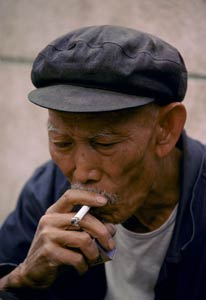Smoking ban in China follows Fogarty-supported work
May / June 2011 | Volume 10, Issue 3

Photo by Curt Carnemark/World Bank
In its efforts to improve public health,
China has banned smoking in public places.
The world’s largest consumer of cigarettes has banned smoking in enclosed public places, marking a significant victory for two Fogarty grantees who designed intervention programs.
China’s ban, which went into effect May 1, 2011, includes hotels, restaurants, theaters and waiting rooms at railway stations and airports, among other enclosed places. The regulation also bars cigarette vending machines in public places.
The owners of public locations are also required to display conspicuous non-smoking signs and carry out promotional activities to warn people about the dangers of smoking.
According to WHO statistics, one of every three cigarettes consumed worldwide is smoked in China and a staggering 3,000 Chinese die every day from smoking related causes. China has more than 300 million smokers and more than 700 million people are routinely exposed to secondhand smoke.
Fogarty grantees Dr. Jonathan Samet and Dr. Teh-wei Hu have pursued methods of curbing smoking in China. Dr. Samet, director of the Johns Hopkins Institute for Global Tobacco Control, used support from Fogarty to collaborate with the Chinese Academy of Medicine to design an intervention program to reduce environmental tobacco smoke exposure at home.
Samet’s Fogarty-supported work in China first centered around interventions and capacity building, and the grants built upon long relationships he had formed with skilled Chinese researchers.
"I think it’s a good step forward and let’s hope it’s put into force; that’s what’s critical," Samet said. "It will be very interesting to see what happens in the rural areas."
In another Fogarty-supported study, Dr. Hu and his colleagues from the University of California, Berkeley, and other UC campuses examined the economic costs of smoking, the impact of a tobacco tax and the cost effectiveness of tobacco control interventions. Their work demonstrating the results of a tobacco tax enabled Chinese health officials to endorse national policy changes regarding tobacco sales.
More Information
To view Adobe PDF files,
download current, free accessible plug-ins from Adobe's website.
Related Fogarty Programs
Related Global Health Research Topics